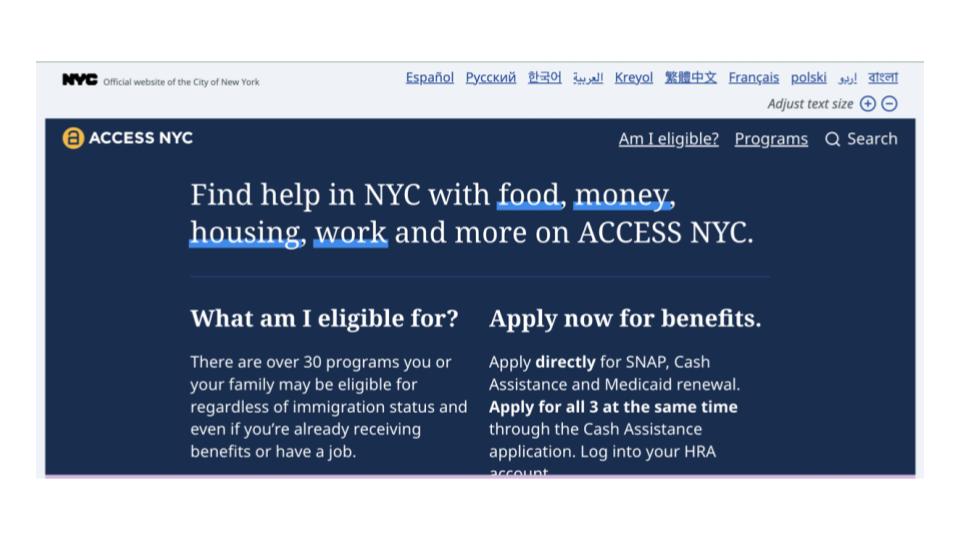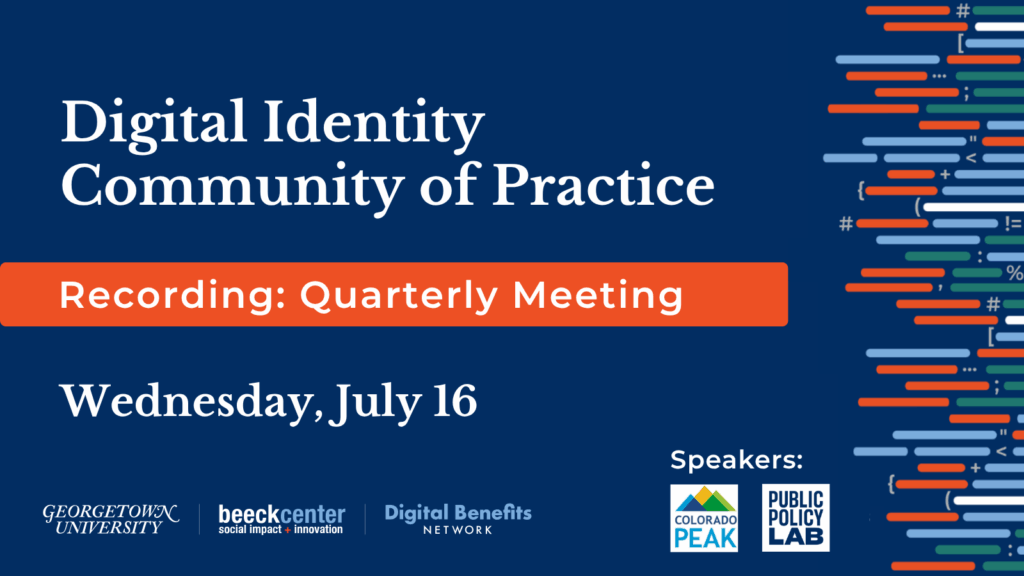Project Snapshot: ACCESS NYC & Benefits Screening API
The NYC Mayor’s Office for Economic Opportunity (NYC Opportunity) developed the NYC Benefits Platform, including ACCESS NYC, to help residents easily discover and check eligibility for over 80 social programs. This mobile-first, open-source tool uses a simple eligibility screener, reducing access barriers while allowing integration with other city services like MyCity, ensuring efficient access to benefits.

Organization Description + Mission
New York City Mayor’s Office for Economic Opportunity (NYC Opportunity) uses evidence and innovation to reduce poverty and increase equity. The multidisciplinary team funds and scales new approaches, uses methodologies such as service design, digital product development and data integration to improve access to social services, and provides research, including the poverty measure for the city.
Approach to Eligibility
NYC Opportunity offers a suite of digital products, datasets and APIs that comprise the NYC Benefits Platform, which supports organizations that make it easier for residents to discover and be aware of multiple benefits they may be eligible for. The platform also helps to accelerate the creation of new technology tools for benefits discovery and navigation.
The platform includes ACCESS NYC, NYC’s public benefits information site and eligibility screener. The website serves as a one-stop-shop where residents can learn about over 80 city, state, and federal social safety net benefits and programs (including how to apply and what documents are required), check their eligibility for more than 40 benefits and programs, and find help nearby, all in eleven languages.
ACCESS NYC was originally launched in 2006. In 2016-2017, NYC Opportunity led a comprehensive re-design of ACCESS NYC with residents, benefits navigators and government staff to launch the mobile-first, accessible site including the 10-step eligibility screener. The screener is designed to reduce barriers to access by collecting a minimal amount of information in order to calculate potential program eligibility and not requiring an account. Once someone has screened, they are offered plain language program guides about each benefit and the ability to text or email the results so they can easily access them later. Since the onset of the COVID-19 pandemic, site traffic has increased to hundreds of thousands per month with a total of more than 6.4 million browsing sessions and 326,000 eligibility screenings completed.
Rules Structure + Technology
ACCESS NYC’s content and code are open source. The core site is built using WordPress and hosted through WPEngine. The site utilizes the ACCESS NYC Patterns design system, which borrows elements from other open source design systems including the U.S. Web Design System.
ACCESS NYC pulls its program guide content from the Benefits and Programs API which is hosted for public use on the NYC Open Data portal. This allows content to be updated without code-based changes.
The eligibility screener is built as a single-page javascript application that utilizes an API to call a Drools-based rules engine. By keeping the rules engine standalone from the screener, it allows for any front end to be utilized against the rules parameters. The NYC Opportunity team is currently evaluating a possible replatform of the rules engine to make it easier to maintain with less specialized skills, while providing a continued level of open access to the rules.
The NYC Benefits Screening API provides open developer access to the rules engine and machine-readable calculations and criteria for the 40+ programs that the ACCESS NYC screening questionnaire screens for. NYC Opportunity also publishes a comprehensive guide to the information utilized to write the rules, a chart to track eligibility categories by program, and a guide to the screener questions.
When NYC’s Office of Technology and Innovation (OTI) started development on MyCity, a new, unified platform for _all _city services and benefits, they were able to reuse and build on the NYC Benefits Platform API. Because the API was easily discoverable and integratable, the OTI did not need to recreate previous work, and the eligibility logic for benefits eligibility could still be maintained in a single location. While there is robust technology and documentation to support utilizing the rules in other solutions and use cases, the policy and incentives for additional agencies and organizations to adopt the solution have not yet followed.
How They Write Rules
When NYC Opportunity and their contractor Blue State Digital replatformed the ACCESS NYC rules onto Drools in 2016-2017, they established a common syntax for writing the rules to serve the 10-step screening question parameters, and which has now served as the basis for making continual updates and adding more programs. The NYC Opportunity team tracks recurring changes, policy updates, and poverty threshold changes with city, state, and federal agency liaisons. The agency liaisons also participated in design sessions and quality assurance testing of the new screener and rules engine before launch. When adding a new program, the NYC Opportunity business analyst and product manager work together to evaluate the eligibility criteria against the ten questions asked in the screener to interpret the explicit thresholds and requirements into conditional logic, which can then be implemented by the software developer as rules statements in the rules engine. The rules are tested using an automated testing tool called Ghost Inspector, which allows the team to run scenarios against the rules to ensure they pass or fail as expected.


